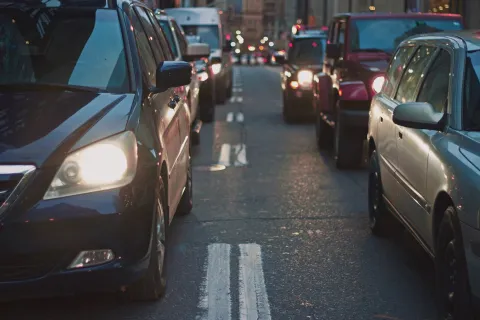Keeping road traffic down in a post-pandemic world

Strong bicycle networks, priority pedestrian areas and other active transportation measures are key to preventing a massive sustained shift from public transit to car travel after the COVID-19 pandemic ends, a recent study by UBC civil engineering professor Dr. Alex Bigazzi suggests.
For various reasons, city dwellers worldwide have been quicker to take private cars than public buses or trains during the pandemic. They have also been slow to return to transit when pandemic-related restrictions have eased. This has caused widespread concern that post-COVID-19 motor vehicle traffic will not just match, but surpass pre-pandemic levels.
However, by making it more attractive for people to bike or walk to their destinations — especially if they are under 10 kilometres away — cities may be able to avoid such an unsustainable fate.
"Initiatives like pop-up bike lanes, car-free zones, e-bike subsidies and bike or walk-to-work paybacks — which many cities have already implemented during the pandemic — could go a long way toward reducing the shift from transit to driving following the pandemic," says Dr. Bigazzi, who also serves on the faculty of UBC's School of Community and Regional Planning.
Analyzing transport data from several major cities in North America and Europe, Dr. Bigazzi and his colleagues estimated how much transit use could decrease in those places after the pandemic ends.
The team then determined how feasible it was for the cities — Vancouver, New York, London and Rome among them — to shift those transit trips to active transportation rather than private drives. This was based on how people there traveled prior to the pandemic, what percentage of car and transit trips were under 10 kilometres in length and varying levels of reduction in transit capacity.
All the cities, they found, would require a significant increase in active transportation in order to avoid busier streets in the future. Yet while achieving this would be more challenging for cities with heavy pre-pandemic transit use and underdeveloped active transportation systems, such an increase is still possible because the trips people make are mostly short-distance. For example, the median commute distance in Canada's eight largest metropolitan areas is between 6.6 and 10.5 kilometres, while nearly 60 per cent of all private motorized vehicle trips in the United States are under 9.7 kilometres.
"If cities want to stay on track to meet their sustainability goals, they need to take action now to make their transportation systems more multi-modal," says Dr. Bigazzi. "This means building transport networks that support multiple modes of transportation — particularly walking and cycling — wherever possible."
The study was co-authored by Francesca Ciuffini and Simone Tengattini at Rete Ferroviaria Italiana, the Italian railway infrastructure manager, and published in Transportation Research Record.
Photo by Nabeel Syed on Unsplash


